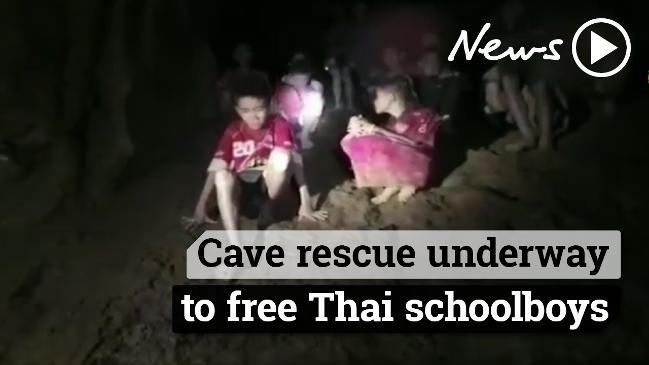Cave diving hero John Volanthen reveals what saved the Thai cave boys
Cave diving hero John Volanthen reveals the five craziest ideas ‘armchair gurus’ gave expert rescuers to save the Thai cave boys.
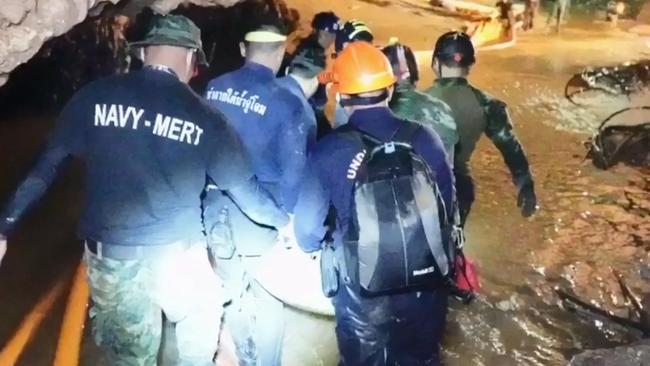
News
Don't miss out on the headlines from News. Followed categories will be added to My News.
John Volanthen is a legendary British cave-diver and one of the two-man team that discovered and rescued the Wild Boars soccer team from the flooded cave in Tham Luang, Thailand. The book Thirteen Lessons that Saved Thirteen Lives details a deeply revealing and nailbiting account of that incredible rescue.
DAY ELEVEN THURSDAY 6 JULY 2018
So what was the plan? Given how protracted the rescue operation needed to be, and how its success would hinge on organisation and logistics, Rick (Volanthen’s regular diving partner Rick Stanton) took the unusual step of going back to the drawing board – quite literally.
A survey of the cave was obtained, and a map sketched on to an A2 board that morning. Detailing every air chamber and cavern, plus dive base and the line locations – and, of course, the gloomy space in which the Wild Boars had been pinned – the map was then overlaid with several sheets of clear plastic. Each one allowed us to add and remove relevant features, such as any potential spots where we could stage air cylinders, or areas in which to swap our equipment.
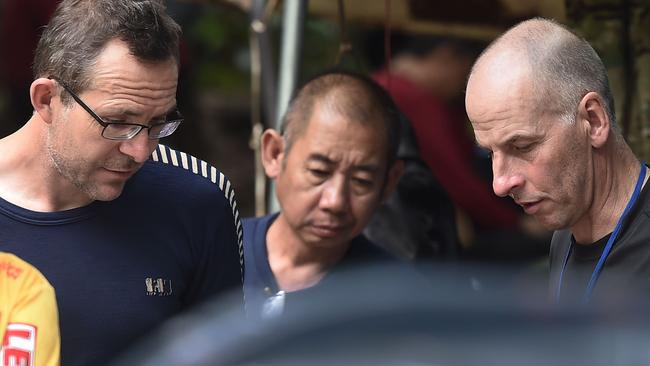
By studying the map, everyone was able to visualise the terrain ahead of us more accurately. I can remember how Rick’s board was initially viewed in some quarters with scepticism. Certainly, the idea of his taking an entire morning to draw out a map appeared to be an unaffordable extravagance. But once the schematics of Tham Luang were relocated to the US air force encampment, our A2 map became a vital cog in the rescue machine: it was referred to continually throughout planning meetings and briefings, but more than anything, it served as a reminder of just how complicated the Wild Boars’ extraction would be.
And so we worked hard to ensure our processes remained as uncomplicated as possible. If ever the phrase ‘Keep it simple’ seemed appropriate, it was during those discussions as Rick and I worked with the American military to establish an uncomplicated, but realistic plan. There was no point in rushing, either. We were in Thailand for the long haul.
Eventually our planning focused on four key areas:
1. The extraction process.
2. Equipment.
3. The team.
4. The transportation of the boys as we swam them through the caves.

All manner of imaginative suggestions were being sent our way from the public. Some were delivered to us directly, others arrived via the British Cave Rescue Council. The senders had been tuned into our predicament thanks, in part, to the twenty-four hour news cycle in place, but very few of the notes were helpful. In the outside world, everybody had suddenly become an armchair guru on the subject of cave rescues, and the tone underpinning 99.9 per cent of what could only be described as brain farts was one of assumed expertise: ‘Children’s lives are at stake. I can save them! You have to listen to me.’ Having said that, a few caught my eye, mainly because they were so outlandish.
#1: The Great Sausage Plan
The scheme: ‘Why don’t you run a one-metre- diameter plastic tube from your dive base to the children? You could inflate it somehow and then have them all crawl to safety?’
Reality check: The Great Sausage Plan would have required around 1.5 kilometres of highly durable plastic in order to work. Even if the tube could have been laid through Tham Luang (spoiler alert: it couldn’t), any leak that sprung as the children moved inside would have been disastrous. The tube would have collapsed, trapping everybody in much the same way a skin, or membrane, binds the sausage meat in a pork banger. (Hence the name, The Great Sausage Plan.)
#2: Drill For Victory!
The scheme: ‘Here’s an idea: why don’t you drill a hole from the top of the mountain all the way down to where the children are sheltering? Then you can winch them out.’
Reality check: The speleological survey covering the Tham Luang system wasn’t anywhere near accurate enough, so locating those kids from a kilometre above would have been close to impossible. Also, who knew what the geological implications of such an effort might be? Sure, this style of rescue had previously worked when thirty-three workers became trapped inside a Chilean mine in 2010, but that was only possible because the area and the tunnels had been surveyed in much greater detail.
#3: The Yellow Submarine Plan
The scheme: ‘Why don’t you use Gamow bags (an inflatable, hyperbaric bag used to treat people when suffering from altitude sickness) to transport the kids? You can seal them inside, one by one, and move them through the tunnel.’ Reality check: Like The Great Sausage Plan, one tear would result in the single sausage collapsing and leaking, drowning the boy inside. And that’s if the bags were able to fit around the bends in the passage, which they wouldn’t. (There was also the 1000kg of weight required to sink the thing.)
#4 Swim For Your Life!
The Scheme: ‘Why don’t you teach the children to become expert scuba divers, then have them make their first-ever cave dive downstream guided by two divers – one in front and one behind.’
Reality Check: We had been told that many of the Wild Boars couldn’t actually swim, and none of them had any diving experience. Even with underwater support, at some point the children would inevitably panic and drown themselves – and probably their rescuers – due to a lack of communication and experience.
#5: The SpongeBob SquarePants Plan
The Scheme: ‘Couldn’t you use a series of giant sponges to soak up the water and then transport them away?’
Reality check: I think the flaws in this one are fairly obvious, don’t you?
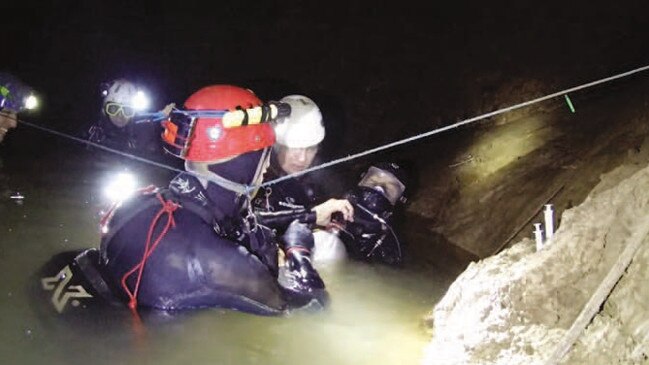
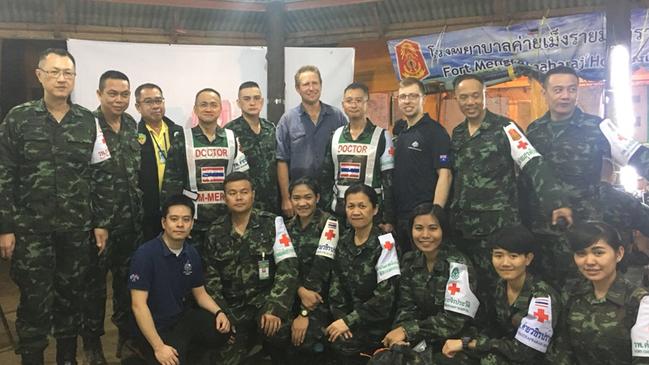
These suggestions, while well meaning, ended up being nothing more than an occasional moment of light relief from the stressful atmosphere that was building around us – a mixture of fatigue, anxiety and tension. Rick and I knew that to succeed we would have to think in an entirely different way to everyone else, by stripping back the very concept of a rescue to its barest bones and eliminating as many complications as possible.
What resulted was a scheme that appeared incredibly basic in theory: One diver takes one child and transports him throughout the entire flooded section of the cave, while the passenger breathes through a single demand valve* all the way. But there was a caveat to this idea that betrayed its undeniable fragility: There would be very little redundancy of equipment and, therefore, zero room to screw up. While there were clearly a number of risks in play because, well, cave diving is inherently full of risks, it really was the best option on the table.
There was one thorny issue: how the hell were we going to stop the boys from panicking or thrashing about underwater? Then Rick made a dark suggestion. ‘Let’s carry the kids out unconscious,’ he said.
At first I thought I had misheard him. By the looks of it, so did the others in the room. Everyone gawped. What do you mean? ‘Maybe we should sedate them?’ While this might have sounded incredibly cold, it did deal with one of the most pressing complications within The Package Plan, which was that unlike air cylinders, or habitats, the packages in question would not in any way be inert. They were young boys; they would be frightened. Some of them would freak out, wriggle and potentially die while being dragged through the murky waters, spaces that had intimidated plenty of experienced divers working on the operation. (These meltdowns might also put the rescuers at risk.)
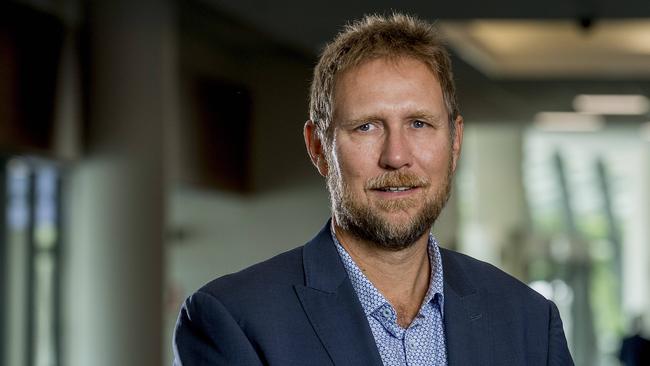
But by using sedation, the logistic problems of moving the boys would be translated into a medical issue, one that appeared much simpler to solve – we only had to find someone who could figure out a suitable drug and dosage.
The idea was kicked up the chain of command for consideration. While we awaited their response, Rick’s sedation theory was floated with Doctor Richard ‘Harry’ Harris – a professional aeromedical consultant and an anaesthetist with the South Australian Ambulance Service.
Harry was also an experienced cave diver, and had been at home, packing for an expedition to the Nullarbor cave region on the southern coast of Australia when we contacted him. The response to Rick’s texted message was emphatic. NO. ABSOLUTELY NOT. Harry sensibly pointed out that the use of anaesthetics still presented certain risks, even in an operating theatre surrounded by the paraphernalia of modern medical equipment and support personnel.
He then went on to explain his concerns regarding the sedation of malnourished and dehydrated kids stuck inside a cave. But we were all out of other options.
Rick was determined to press the issue. ‘If we do nothing, they’re all going to die,’ he said. Eventually, Harry agreed to be persuaded and then, if the evidence proved compelling enough, he would reconsider. ‘I’ll come to Thailand to assess the situation myself,’ he said. ‘And I’ll bring my dive partner, Craig Challen, too.’
Craig was an experienced diver and a full-time vet, and with no time to lose, the logistic details of what would be required should Harry give us the thumbs-up were thrashed out between Rick and me. Both of us reckoned on Harry siding with the plan, especially once he had seen the Wild Boars’ predicament close up, and so the mission was renamed as The Inert Package Plan.
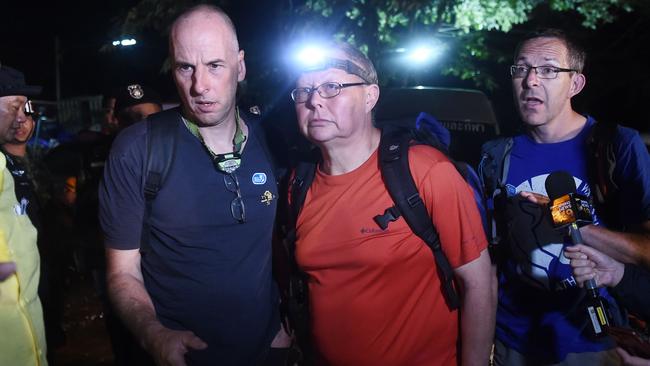
But none of us had really thought out the realities of such a sedation event. Not fully, anyway. When first imagining the process, I had pictured a woozy kid with floppy limbs. He was able to hold eye contact and carried just enough presence of mind to respond to my commands. I soon learned that this had been an oversight on my part, and I would have to revise my visualisation of exactly what was coming down the line, as well as the details regarding the kids’ physical state during the rescue. The truth, when it arrived, would seem very unnerving. Ketamine was discussed as the sedative of choice, and for good reason: it would render the boys completely unconscious and that ensured they would have no memory of their traumatic journey.

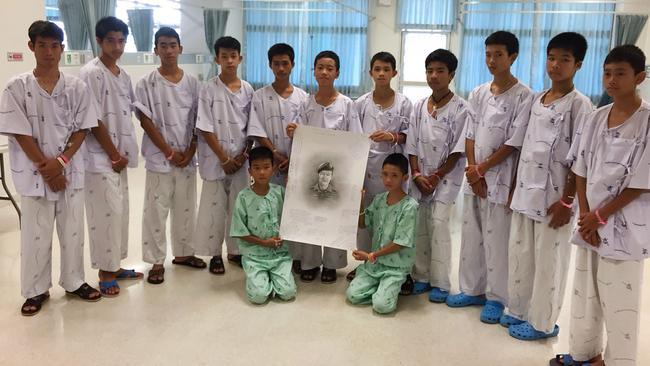
Most important of all was the effect it had on a person’s breathing. A number of studies had been conducted by the Australian Antarctic Survey, in which a group of seals had been administered ketamine. The results had shown that the mammals’ airways remained fully functional despite having fallen unconscious.
It was hoped that this characteristic, combined with the positive pressure masks, would ensure the Wild Boars’ breathing remained stable throughout their extraction. That’s not to say we felt 100 per cent comfortable with the decision. Sedating Antarctic seals was one thing. Sedating humans and then swimming them underwater for 1.5 kilometres and carrying them over rocky stretches represented a desperate rescue effort, and had never been attempted before.
More Coverage
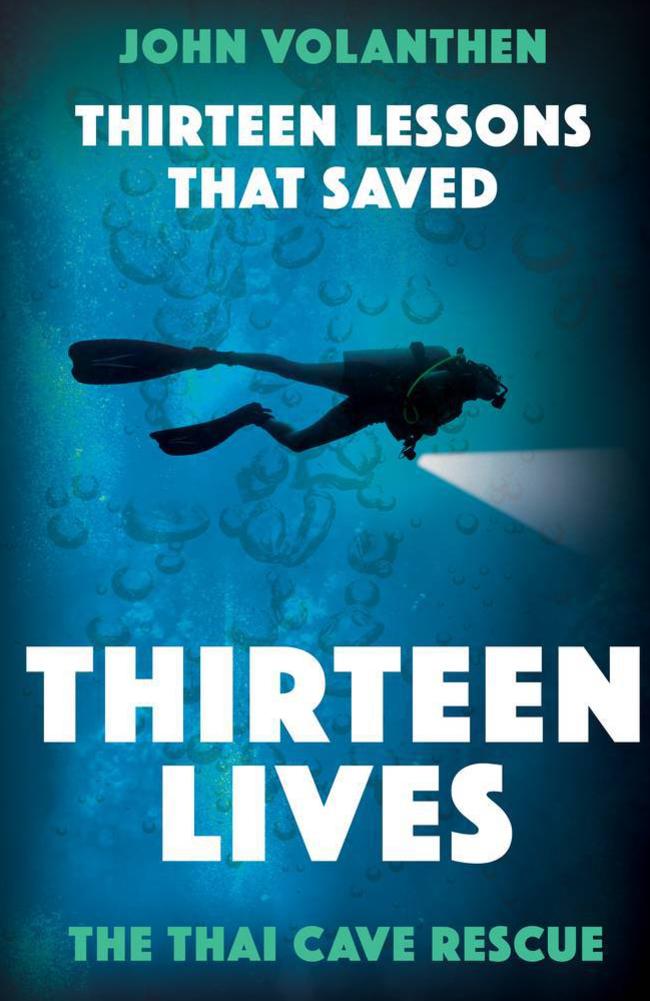
Originally published as Cave diving hero John Volanthen reveals what saved the Thai cave boys

